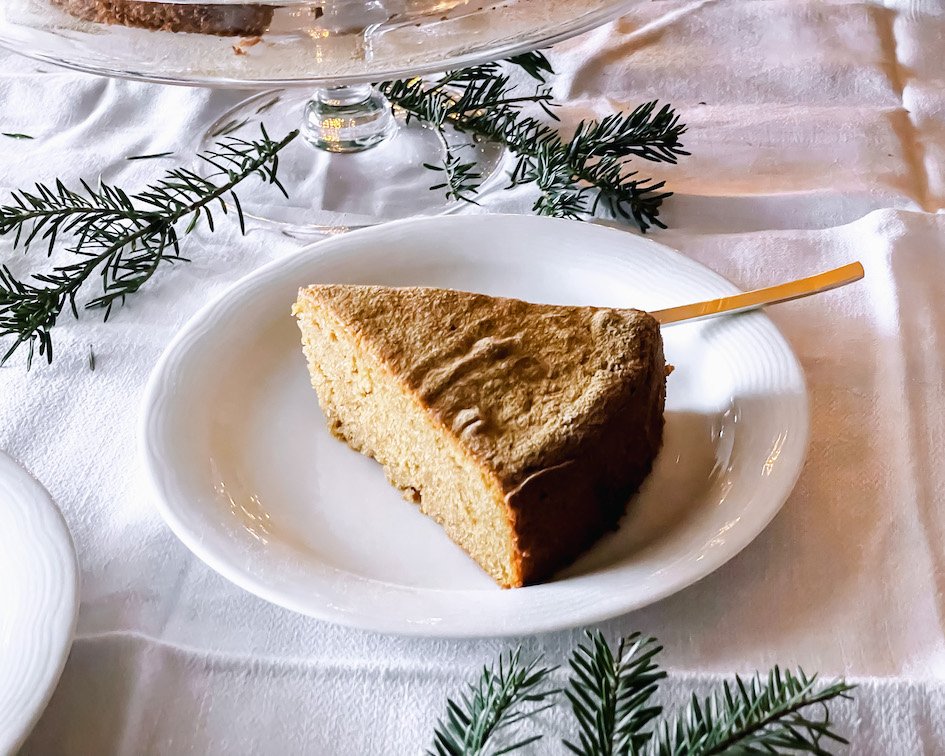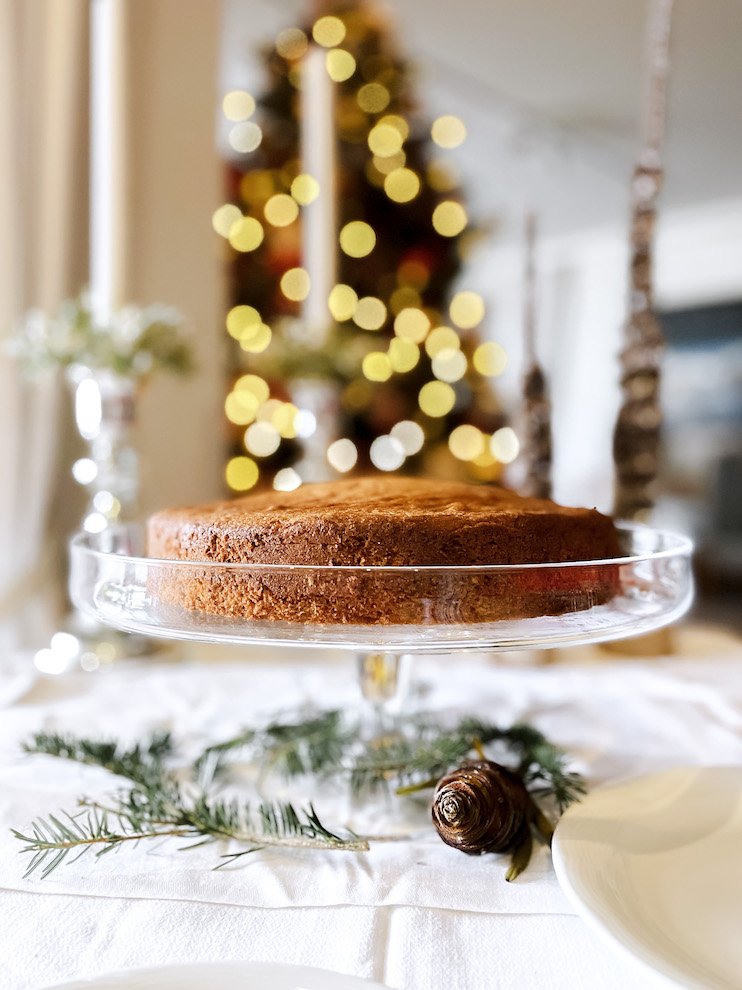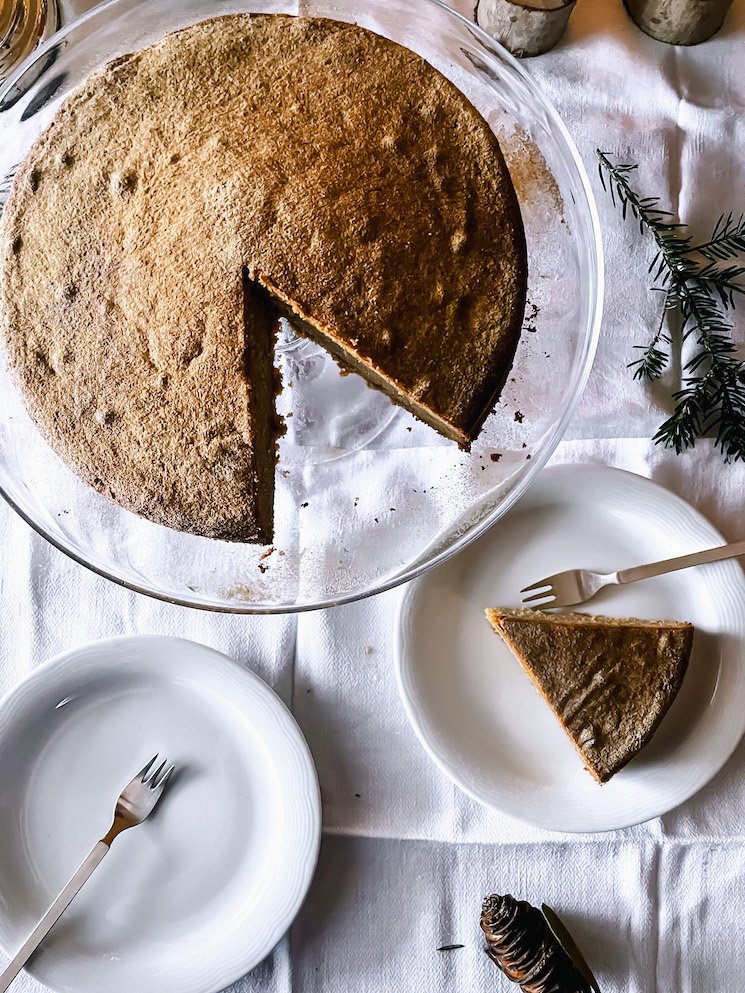Gluten-Free Vasilopita (Greek New Year’s Cake)
GLUTEN FREE · DAIRY FREE
Vasilopita is a New Year’s tradition in my native Cyprus, Greece, and other areas of Eastern Europe and the Balkans. It’s a sweet, bread-like cake made specifically for New Year’s, and is usually sliced just after midnight on New Year’s Eve, or at some later time during New Year’s Day. A coin is typically hidden in the base of the cake and a family cuts as many slices as there are people present, or in the family (one piece to represent each person). Some people also cut extra slices to represent the home in which the cake is being served, ‘the poor man’, and St Basil, after whom Vasilopita is named. Once each slice has been handed out, the search begins! Everyone turns their cake over to see if the lucky coin is hiding in their slice. Whoever finds the coin is said to be bestowed with good fortune for the coming year, and many people often have a trinket to gift to the coin-finder, to represent this good fortune. If the slice of ‘the poor man’ has the coin, then a donation to charity is usually called for.
As for St Basil, or Ayios Vasilis as he is called in Greek (which, incidentally, is also the Greek name for Father Christmas/Santa Claus), the original story goes a little something like this: St Basil was a bishop in Caesaria, which, one day came under siege. St Basil called upon the community to raise money to pay to the enemy as ransom. Each citizen handed over anything of value they had, be it gold or jewels. When this was handed over to the enemy, upon seeing the collective generosity, they were allegedly so ashamed that the threat was withdrawn and they left peacefully. As it was now too difficult to distinguish which gold and which jewels belonged to which citizen, St Basil had them all baked into bread and distributed it back to the people in this way, and miraculously, everyone ended up with what was rightfully theirs! And so, in honour of St Basil, people bake this bread every year for St Basil’s day, January 1st.
Continuing the Basil saga, the original recipe for this cake was given to me when I was 15 years old, by a very close family friend, called Vasiliki (the female version of the name Vasilis - aka Basil). As a child, I couldn’t say her name properly, and so I called her Billy, and still do! So, both because she gave me the recipe, and because the name of the cake contains the first half of her name, Vasilopita has since been referred to as Bilopita in my house, or ‘Billy-cake’! Recipes for Billy-cake vary slightly depending on the region, but I have never liked any other version I’ve tried, so have remained true to this one.
I think I have made it pretty much every New Year’s since I was given the recipe (that’s a lot of cake!), even after I discovered that gluten and I did not get on, which meant that I would either forego my slice altogether, or I would have some and then not feel great afterwards, which I always felt was not the best way to start a new year! So this year I decided I would mess with the otherwise perfect recipe, and make it gluten-free, and as healthified as possible. This meant ditching the wheat flour, refined sugar, butter and corn starch, and playing around with alternatives. I’m happy to say the result is really very close to the original, the main difference being that it comes out a darker colour, due to the coconut sugar used.
It’s the perfect accompaniment to your New Year’s Day tea or coffee, whether or not your slice contains hidden treasures!
Ingredients
Coconut sugar
Coconut sugar is a great substitute for refined sugar. Also called coconut palm sugar (not to be confused with palm sugar), it is not as processed and even contains small amounts of certain nutrients.
Coconut sugar contains potassium, magnesium, and sodium, which are important for balancing electrolyte levels in the body. Regular table sugar has a glycemic index (GI) of 65, while coconut sugar has a GI of 35 (much closer to the GI of the sugar that’s naturally found in fruits - around 25).
Coconut oil (odourless), or vanilla ghee
Softened coconut oil works best for this recipe, so if yours is solid at room temperature, warm it up so it softens to a spreadable consistency before using.
Coconut oil is a great oil option for sweeter dishes. I recommend an odourless version for this recipe, so that you don’t get a coconut taste coming through as it’s definitely not a traditional Vasilopita flavour! However, if you simply love coconut, feel free to use a regular coconut oil.
If you do not need to avoid dairy, or you do but can tolerate ghee, then I would very much recommend trying this recipe with this vanilla ghee - I love using this product, and it really adds a richness of flavour to the cake here.
Eggs
Lemon zest
Make sure to wash lemons before you zest them, otherwise you just end up ingesting anything and everything that has come into contact with the fruit! This is especially important if the lemons are not organic, unless you want your baking with a peppering of pesticides (yes, the alliteration was deliberate, I couldn’t help myself).
Lemon juice
From an actual lemon, not a bottle!
Almond flour
Sometimes also called almond meal, you can find this ready-made or you can simply throw some blanched almonds into a food processor and grind them down into a fine flour.
Almond flour has an impressive nutrient profile (rich in protein, fibre, vitamin E and good fats), and is also low-carb, making it a key player in gluten-free baking.
Rice flour
Neutral in flavour, rice flour is a common substitute for wheat flour in gluten-free baking.
You can use either white or brown rice flour here, but bear in mind that whichever you opt for will affect the resulting colour of the cake. For this reason, I went with white rice flour, as the cake is already made a little darker as a result of the coconut sugar.
Arrowroot starch/Tapioca starch
You can use either arrowroot or tapioca starch/flour in this recipe. Both are great binders in gluten- and grain-free baking, and make a good substitute for corn starch in recipes. Arrowroot seems to have slightly more nutritional benefits than tapioca starch, but there’s not enough of a difference for the quantity per serving here for you to worry about choosing one over the other. Whichever you have on hand will work just fine!
Baking powder (gluten free)
Salt
Optional toppings:
Paleo Icing Sugar: Coconut sugar + Tapioca starch
Desiccated coconut
Flaked almonds
Lemon zest
Changes & Substitutions
Topping options
You don’t have to decorate the Vasilopita, but why not? I opted for a little Paleo icing sugar on top, which is basically just coconut sugar and tapioca starch blended down into a fine dusting powder.
You could also go with a sprinkling of desiccated coconut (though coconut is not a flavour typically associated with Vasilopita, but it will be pretty!), some grated lemon zest, or even flaked almonds.
Vanilla ghee for a richer flavour
While this recipe works very well with coconut oil, I personally prefer it with this vanilla ghee, even if it does mean that the cake will not be dairy free. I haven’t tried it with regular ghee (with added vanilla essence), but that is certainly something you could attempt if you wish!
Oranges and lemons?
Many people’s idea of a traditional Vasilopita is one made with orange, rather than lemon, or a combination of the two. I vastly prefer lemon to orange, so it’s an easy choice for me to make, but feel free to use both, or sub orange for lemon altogether if you prefer.
Tips
‘Tenting’ the cake
Whether or not you need to do this will largely depend on your oven. If I skip this step, the top of the cake catches and gets a little burnt, so I would definitely recommend taking the precaution. At around 20-25 minutes into the baking time, carefully remove the cake from the oven, and place it on the centre of a large piece of aluminium foil, approximately 3 times as long as the width of your baking tin. Lift both ends of the foil to make a large triangle over the cake, and fold/roll the top ends down together so they stay attached. It should look like your cake is sitting in a foil tent! Then place the cake back into the oven for the remaining baking time.
The coin!
If you will be doing the traditional coin-hiding in your Vasilopita, the ‘cleanest’ way to do it is to wash the coin and then wrap it in a little aluminium foil. Push the coin into the underside of your cake vertically, so that it is ‘standing’ inside the cake. Then, once you’ve placed your cake onto your serving dish/stand, rotate it a few times so you don’t know where the coin is and can proceed with unbiased slicing!
Icing sugar just before serving
If you are using Paleo icing sugar to decorate your Vasilopita, wait until just before serving to sprinkle it over the cake, because it tends to sink in and disappear, defeating its decorative purpose!
Slicing
Traditionally, you make the first slice vertically down the centre of the cake, essentially cutting the Vasilopita in half, and then horizontally, quartering it. From here you proceed to cut as many even-sized slices as the people you are cutting for. Some people like to have little ‘name flags’ on cocktail sticks to stick into their slices, so that there can be no confusion over which slice belongs to which person!




